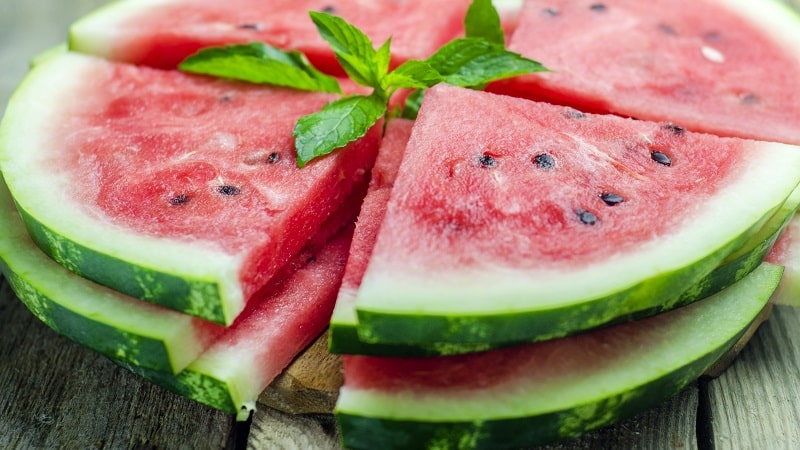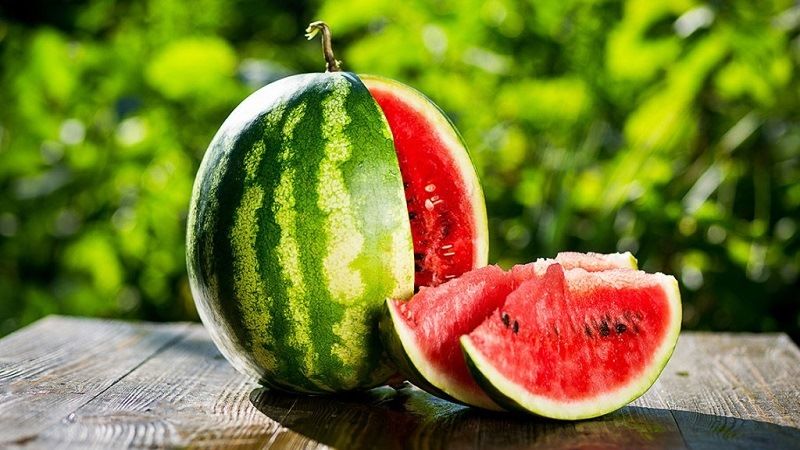What is the glycemic index of watermelon, and what nutritionists think about it?
Watermelon consists mainly of water and sugars. From mid-August to the end of September, nutritionists recommend consuming watermelon, including for weight loss. Despite the high glycemic index - up to 80 units, its calorie content is low and amounts to 30 kcal per 100 g of pulp.
In the article we will talk about the composition of the berry, consider its beneficial properties and application features.
Chemical composition of watermelon
Watermelon consists of 91% water and 6% carbohydrates, and has a low fat content (0.1% of the daily value).
It contains little fiber - only 0.4 g per 100 g, but is famous for its high content of various vitamins and minerals:
- Vitamin C (13% of normal). This antioxidant is essential for healthy skin and immune system.
- Vitamin A (11% of normal). Performs a number of functions: it is important for growth and development, for maintaining the immune system and good vision.
- Potassium (3% of normal). This mineral is important for blood pressure control and heart health.
- Magnesium (2% of normal). Magnesium ions regulate more than three hundred biochemical reactions in the body as enzymatic cofactors.
- Copper (2% of normal). The element takes part in the production of red blood cells. It is important in the synthesis of hemoglobin. Strengthens the walls of blood vessels and capillaries, affects pigmentation, and is responsible for the strength of bone tissue.
- Manganese (2% of normal). Manganese is essential for the metabolism of cholesterol, carbohydrates and protein.
- Vitamin B5 (2% of normal). Aka pantothenic acid.Participates in the synthesis of carbohydrates and fats, plays an important role in maintaining the functioning of the digestive tract.
- Vitamin B6 (2% of normal). Helps the body produce the “happy” hormone serotonin and norepinephrine, which helps the body cope with stress.
- Thiamine (2% of normal). Thiamine plays an important role in breaking down carbohydrates from food into substances needed by the body.
The berry contains citrulline and lycopene. The first is transformed in the body into the essential amino acid arginine. Both citrulline and arginine play an important role in the synthesis of nitric oxide, which helps lower blood pressure by dilating and relaxing blood vessels.
Lycopene is a powerful antioxidant that gives watermelon its red color. The body uses lycopene to form beta-carotene, which is then converted into vitamin A.
Reference. Watermelon seeds are a rich source of protein and oil: they contain about 35% protein, 50% oil and 5% dietary fiber.
What is the glycemic index of watermelon?
Glycemic index (gi) is a measure of how quickly a food causes blood sugar levels to rise, and people often wonder what it is like in watermelon. The indicator is quite high - 72 and even 80 depending on the variety.
But a serving of watermelon (150-200 g) contains few carbohydrates (15.2 g), so eating it will not have a significant effect on blood sugar levels. Glycemic load per 100 g of product – 6 g of carbohydrates (sugars). By the way, melon has a glycemic index lower than watermelon, but still above average - 65.
Calorie content
Nutrients per 100 g of raw watermelon:
- calorie content - 30 kcal;
- water - 91%;
- proteins - 0.6 g;
- carbohydrates - 7.6 g (of which sugars - 6.2 g, dietary fiber - 0.4 g);
- fats - 0.2 g.
The watermelon diet is an effective way to lose weight and naturally detoxify the body. Its properties and benefits for weight loss:
- has diuretic and tonic properties;
- low calorie;
- water source: watermelon contains 90 to 95% water, so it is a natural thirst quencher;
- a source of fiber that has a beneficial effect on metabolism;
- Suitable for diabetics because it is low in sugars.

Useful properties of berries
Watermelon is rich in carotenoids, including beta-carotene and lycopene—beta-carotene helps lower blood pressure, and lycopene helps boost immunity.
Cucurbitacin E is a highly oxidized steroid with antioxidant and anti-inflammatory effects.
Watermelon contains citrulline, an amino acid that increases nitric oxide levels in the body. Nitric oxide helps blood vessels dilate, which lowers blood pressure. Other vitamins and minerals in watermelon are also good for your heart. These include vitamins A, B6, C, magnesium and potassium.
Reference. Citrulline helps the body cope with sore throat (complex muscle pain).
Inflammation is a key aspect of the immune system's response to injury and infection, but problems arise when the inflammatory process continues for too long and becomes chronic. Watermelon helps reduce inflammation and oxidative damage as it is rich in the anti-inflammatory antioxidants lycopene and vitamin C.
Vitamin C Helps the body produce collagen, a protein that keeps skin elastic and hair strong. Vitamin A is important for healthy skin.Not only does it quench free radicals that break down collagen (the skin's supporting structure) and promote the development of rosacea, it also reduces skin sensitivity to the sun, providing natural protection against sun-induced redness and pigmentation.
The advantage of watermelon is that it is one of the few berries, which contains a large number of folic acid. It is important for the proper development of organs, for the healthy growth and development of the child, and normalizes the production of red blood cells. Taking folic acid before and during pregnancy prevents serious birth defects in the baby's brain or spine.

Features of application
The berry is used in folk medicine and cosmetology.
Watermelon in folk medicine
Helps with the following diseases:
- Seeds of watermelon - in Chinese folk medicine, doctors use them as the most powerful remedy for kidney stones. Watermelon seeds are rich in magnesium and potassium.
- For fever, it is recommended to mix crushed berry seeds with hot water. The ratio of components is 1:10. There are no restrictions on the use of the medicinal drink - it can be sweetened with honey or syrup, and given in hot weather, 3-4 tbsp. every 2 hours. l.
- If you suffer from gout attacks, then it is useful to fast for 2-3 days, eating only watermelon pulp. Every two hours you need to eat 200-300 g of pulp. This method helps with joint problems.
Watermelon in cosmetology

Watermelon is an excellent cosmetic skin care product:
- The acids contained in the berry have exfoliating properties. Mix one glass of pulp, crushed in a blender, with sugar.Add lemon juice and store in an airtight container in the refrigerator for up to a week.
- To tighten your facial skin, beat 150 g of watermelon pulp and apply to your face. Leave the mask on for 10 minutes, then rinse with warm water. Combine watermelon puree with yogurt if you have oily skin, or with a banana if your skin is dry.
- To tighten pores, mix a glass of watermelon juice with chopped mint leaves. Freeze the mixture and wipe your face every day before going to bed. This will have a cooling and soothing effect on your skin.
- Mix watermelon and cucumber pulp in equal quantities and apply it to your face and neck. Leave on for twenty minutes, then rinse off. This mask is useful for treating sunburn.
Possible contraindications for use
People with gastrointestinal disorders are not recommended to consume watermelon - it can cause diarrhea. A direct contraindication is any disease associated with impaired urine outflow:
- congenital malformations of the genitourinary system;
- nephrolithiasis;
- prostate adenoma;
- secondary pyelonephritis due to the occurrence of postoperative adhesions.
Due to the fact that the berry contains a lot of cellulose, which takes a long time to digest, it can cause fermentation. Therefore, for patients with typhoid fever, it is not the pulp that is useful, but the strained juice of the berry: flatulence caused by the pulp can be dangerous. The same property can cause colic in babies, which should be taken into account while breastfeeding and the introduction of watermelon into the mother's diet.
As for the last trimester of a woman's pregnancy, in this case we are talking about limiting the consumption of too much watermelon, as this will lead to discomfort and increased urination.
Conclusion
Due to the high water content (more than 90%), the high GI of watermelon does not lead to excess carbohydrate consumption.
Its pulp contains many useful elements. Antioxidants have a positive effect on all body systems. Watermelon relieves fever and inflammation, supports the immune system, stabilizes blood pressure, and improves digestion. The berry is especially useful for kidney diseases - it has diuretic effective and cleanses well.